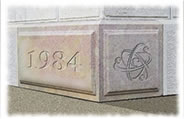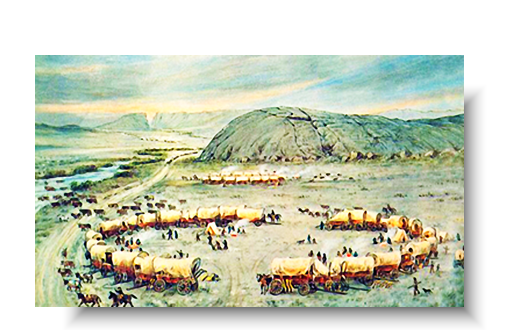Circle the Wagons
“Circle the wagons” (idiom) suggests a group of people who intend to put up the barriers, turn inward and husband their resources as they deal with their own pressing issues. A business can “circle the wagons” when it needs to re-evaluate its products, marketplace or advertising strategy. All of these uses share the common theme of providing for defense from circumstances that can seem overwhelming. (See Dessert…)
In times of great stress or great change, it’s necessary to get the people together, and establish a plan of battle, making sure every player knows their place, their part and their range of free operation.
Is this such a time? Consider:
Politics
New administrations in England, Canada, the U.S., France (upcoming) and Korea. Everything’s unsettled! What’s going to happen? Well, nobody knows… So the uncertainty builds, and people who are never good at dealing with stress, tend to obsess about it, dwell on it and keep reaching for web access and getting distracted by all the claims, counter-claims and conjecture.
News and Media
In prior years, the news was a touchstone of calm, reserve and rationality. “Keep Calm everyone, Mr. Cronkite will keep us informed!” But the “News Media” no longer deals in, you know, “NEWS.” Dedicated as it is, to getting more clicks and shares, the media business has descended into a great war between gossips and viewpoints and dueling corporations and interest groups — each competing for more pay per click from advertisers.
Institutions
Leaks keep surfacing, as formerly responsible outlets keep incinerating their credibility. People find themselves casting a wider net for information and having less and less confidence in their sources.
Who can we trust?
As our formerly stable sources of leadership, information, and ethics keep shifting, it becomes more and more incumbent on the workplace to remain a source of reliable information and steady trustworthy interpretation — so that people can feel confident and comfortable at work. “At least,” we surmise, “we can still trust the Boss, Management and the Board.”
It’s time to “Circle the Wagons!”
How’s that accomplished? Frankly, as a leader, it’s up to you.
- Circle the wagons! Getting your people together, so they can look one another (and you) in the eye. (Gives them confidence that you’re all in it together.)
- Tell them honestly what you know. (Don’t guess or opine, unless you label your opinion accordingly.)
- Tell them how you see this affecting them, the company, their work, and potentially, their future.
- Tell them how you think they should take it. (If I were you, I’d begin thinking and acting this way…)
- Tell them what you plan to do. (This is how it appears to me… This is how I’m planning on dealing with it… They don’t have to do as you do, but they’ll know in advance, and this will dispel any later misunderstandings.)
- If you can do all this in the simplest language with two or three points and a little structure, people will be able to pass along what you say to someone else. (In this marketplace, a clear, repeatable message is a blessing.)
This is, obviously, a huge responsibility.
God Bless Us! May we be up to the challenge!
https://www.high-endrolex.com/36
Applications
1. For You
Take note of the disappearance of figures of trust. The classical sources of good information have disappeared. In their place, we’re getting a series of more and more bizarre pronouncements from an ever larger number of trolls, promoters, self-appointed experts and noisy critics. In a time like this, it might be a good idea to rely on the classic advice: If you can’t contribute something useful or meaningful, maybe better to remain silent and curious.
2. For the Family
Are your children becoming too reliant on social media for their opinions and information? Should there be a family limit on all daily “news” consumption? Does your partner read the screen through the evening meal? Is this rational? Should you attempt to re-discover each other in conversation?
3. For the Office
If you can contribute a rational and restrained note of calm and confidence to the office, do it. But realize that these are indeed perilous times, when voices everywhere are competing to control the tides of public opinion and discourse. The old ways are gone, and the new power structures have not fully revealed themselves. You can help people hang on. Remind them of their shared commitment to what’s best: Calm Honest Discussion. Ethical Restraint. Seeking the best information before acting.
Change, for better or worse; it’s everywhere! Let’s try to keep it from breaking loose and taking rationality with it!
Circle the Wagons, Brief the Team, and Hold On!
Dessert
Wagon Trains / Circle the Wagons
Wagon trains composed of Conestoga Wagons and Prairie Schooners, brought cattle as they moved into the North American West in search of new land to settle, ranch and farm. To corral the cattle at night, and to provide better defense against attack, the wagons were brought into a circle around the herd.
Over 500,000 settlers made the trip out west in the United States in wooden, canvas covered wagons before railroads were completed in the late 1800s. Settlers took all of their belongings with them, and could only start the journey in early spring, as it took four to six months to complete, and had to be done while grass was growing to feed the livestock. Survival of the livestock was essential so to “circle the wagons” at the time was a crucial strategy. As a business today may engage in a “circle the wagons” practice to ensure its own survival, settlers were doing the same thing for themselves when the idiom first originated over 150 years ago.
Sources:
Wiktionary
The Oregon Trail, Francis Parkman
Subscribe to our Newsletter


